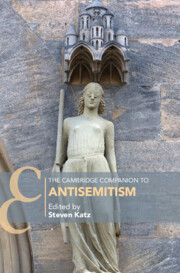Book contents
- The Cambridge Companion to Antisemitism
- Cambridge Companions to Religion
- The Cambridge Companion to Antisemitism
- Copyright page
- Contents
- Contributors
- Acknowledgments
- Introduction
- Part I The Classical Period
- 1 Antisemitism in the Pagan World
- 2 New Testament Origins of Christian Anti-Judaism
- 3 Anti-Judaism in Early Christian Writings
- 4 Church Fathers and Antisemitism from the 2nd Century through Augustine (end of 450 CE)
- 5 Christians, Jews, and Judaism in the Eastern Mediterranean and Near East, c. 150–400 CE
- 6 Christianizing the Roman Empire
- 7 Antisemitism in Byzantium, 4th–7th Centuries
- Part II Medieval Times
- Part III The Modern Era
- Appendix The International Holocaust Remembrance Alliance: Working Definition of Antisemitism
- Index
- Cambridge Companions to Religion
- References
5 - Christians, Jews, and Judaism in the Eastern Mediterranean and Near East, c. 150–400 CE
from Part I - The Classical Period
Published online by Cambridge University Press: 05 May 2022
- The Cambridge Companion to Antisemitism
- Cambridge Companions to Religion
- The Cambridge Companion to Antisemitism
- Copyright page
- Contents
- Contributors
- Acknowledgments
- Introduction
- Part I The Classical Period
- 1 Antisemitism in the Pagan World
- 2 New Testament Origins of Christian Anti-Judaism
- 3 Anti-Judaism in Early Christian Writings
- 4 Church Fathers and Antisemitism from the 2nd Century through Augustine (end of 450 CE)
- 5 Christians, Jews, and Judaism in the Eastern Mediterranean and Near East, c. 150–400 CE
- 6 Christianizing the Roman Empire
- 7 Antisemitism in Byzantium, 4th–7th Centuries
- Part II Medieval Times
- Part III The Modern Era
- Appendix The International Holocaust Remembrance Alliance: Working Definition of Antisemitism
- Index
- Cambridge Companions to Religion
- References
Summary
The institutional, social, and theological rise of an imperial-episcopal orthodoxy in the 4th-century Roman Empire transformed the productive, if not always genial, scriptural and ritual interactions among Jews and Christians in previous centuries into a discourse of theological difference, enabling violence and exclusion.
- Type
- Chapter
- Information
- The Cambridge Companion to Antisemitism , pp. 83 - 99Publisher: Cambridge University PressPrint publication year: 2022

